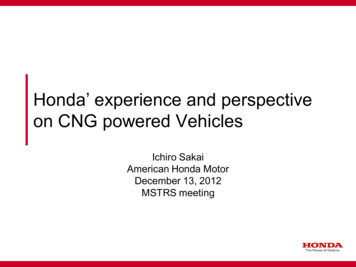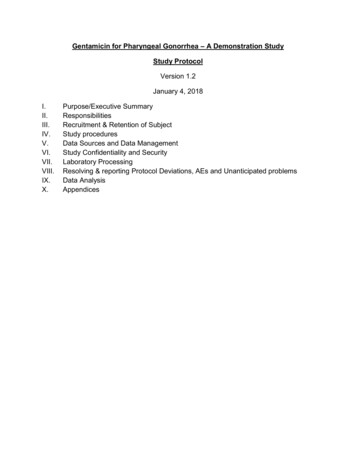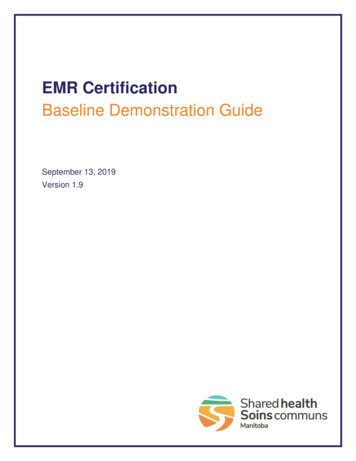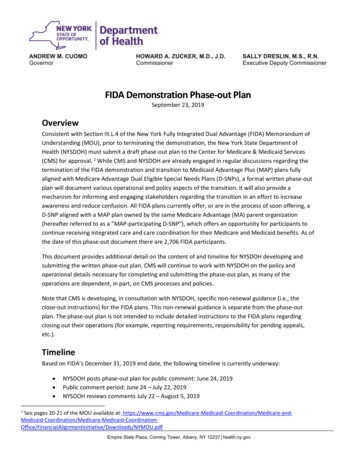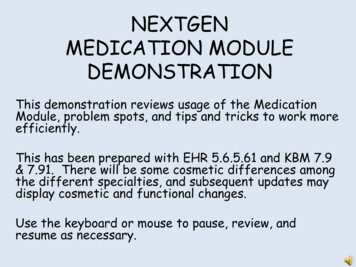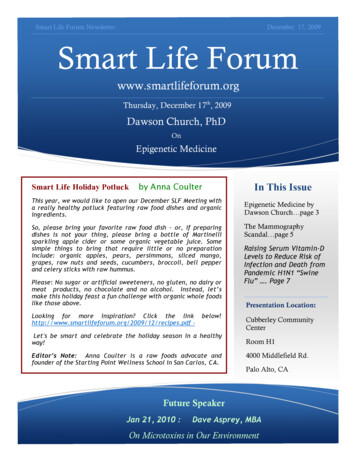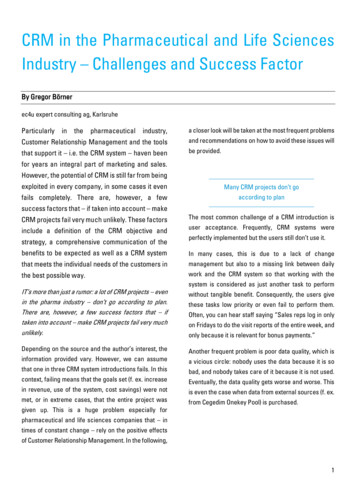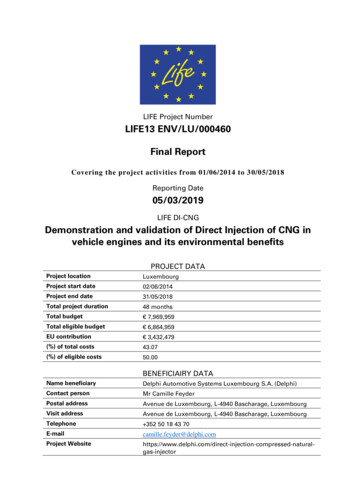
Transcription
LIFE Project NumberLIFE13 ENV/LU/000460Final ReportCovering the project activities from 01/06/2014 to 3 0/05/2018Reporting Date05/03/2019LIFE DI-CNGDemonstration and validation of Direct Injection of CNG invehicle engines and its environmental benefitsPROJECT DATAProject locationLuxembourgProject start date02/06/2014Project end date31/05/2018Total project duration48 monthsTotal budget 7,969,959Total eligible budget 6,864,959EU contribution 3,432,479(%) of total costs43.07(%) of eligible costs50.00BENEFICIAIRY DATAName beneficiaryDelphi Automotive Systems Luxembourg S.A. (Delphi)Contact personMr Camille FeyderPostal addressAvenue de Luxembourg, L-4940 Bascharage, LuxembourgVisit addressAvenue de Luxembourg, L-4940 Bascharage, LuxembourgTelephone 352 50 18 43 70E-mailcamille.feyder@delphi.comProject pressed-naturalgas-injector
1. List of contents1.1. List of contents1.List of contents . 2List of contents . 2List of acronyms . 3List of tables . 4List of figures . 42.Executive summary . 53.Introduction: Project scope and objectives . 94.Administrative part . 104.1. Description of the management system . 104.2. Evaluation of the management system . 115.Technical part . 125.1. Technical progress. 12Injector development, prototyping and testing . 12Pilot process optimization and testing . 16System level implementation . 20Monitoring of the Environmental impact of the injector: . 271.1.1.2.1.3.1.4.
1.2. List of acronymsBEVBMEPBoMCARBBattery Electric VehicleBrake Mean Effective PressureBill of MaterialCalifornia Air Resource BoardLCILCIALCMUSTCBGCH4CHPCICompressed BiogasMethaneCombined Heat Power PlantCarbon IntensityMPFINEDCNGVNGVACompressed Natural GasCarbon monoxideCarbon DioxideCoefficient of VariationDeutsches Biomasse Forschungszentrum(German Research Centre forBiomass)DenaDeutsche Energie Agentur (GermanEnergy Agency)DI-CNG Direct Injection of CompressedNatural GasEBAEuropean Biogas AssociationFCEVFuel Cell Electric VehicleFQDFuel Quality DirectiveFRCFiat Research CenterGasOnHorizon202O research program fordemonstration of monovalent DICNG vehiclesGDiGasoline Direct InjectionCHGGreen House GasGVGeometric VarianceGWhGiga Watt hoursHDPEHigh Density PolyEthyleneHEVHybrid Electric VehicleIAVInstitute for Automotive EngineeringIEAInternational Energy AgencyNm3NMHCNOxPAPFICNGCOCO2COVDBFZPHEVLife Cycle InventoryLife Cycle Impact AssessmentLife Cycle ManagementLuxembourg Institute ofScience & TechnologyManifold Port Fuel InjectionNew European Driving cycleNatural Gas VehicleNaturalGasVehicleAssociationNorm cubic meterNon Methane hydrocarbonsNitrogen OxidesPolyamidePort fuel injectionPMPlug-inHybridVehicleParticulate MassElectricPNParticulate NumberPSAPtGROERNGSGCPressure Swing AdsorptionPower-to-GasReal Driving EmissionRenewable Natural GasSwedish Gas Centre(Svenskt Gastekniskt rbo Gas InjectionTotal HydrocarbonsTurbo Stratified InjectionTank-to-WheelTerra Watt hoursVariable Turbo GeometryWaste Gate
ILCDIRENAJRCLCALCFSInternational Reference Life CycleData SystemInternational Renewable EnergyAgencyJoint Research CenterLife Cycle AssessmentLow Carbon Fuel StandardWLTPWSLWtTWtWWorld harmonized Light dutyvehicle TestSwiss Federal Institute forForest, Snow& Landscape ResearchWell-to-TankWell-to-Wheel1.3. List of tablesTable 2-1 List of dissemination actions . 7Table 5-1 Summary of DI-CNG demonstration activities on engine and vehicle level . 201.4. List of figuresFigure 4-1 Gant Chart - Life project . 10Figure 4-2 Consultancy and External assistance . 11Figure 5-1 Early research injector for 1st. engine tests . 12Figure 5-2 Delphi Technologies GEN6 Di-CNG injector vs. M14 gasoline injector . 12Figure 5-3 DI-CNG system hardware and control system . 14Figure 5-4 The DI-CNG controller hardware . 14Figure 5-5 Interior (left) and exterior (right) of DI-CNG injector durability test stand . 15Figure 5-6 Design of a production line for low volume ( 150,000 injectors / year) . 19Figure 5-7 Summary of DI-CNG demonstration activities on vehicle level . 21Figure 5-8 Comparison of CNG engine configurations with different turbochargers . 23Figure 5-9 Relative CO2 reduction by DI-CNG vs. GDi engine operation . 23Figure 5-10 Power and efficiency curves for Ford GasOn DI-CNG engine . 24Figure 5-11 Conclusions of GasOn project achievements WP2 . 26Figure 5-12 WtW emission results of carbon footprint calculations . 28
2. Executive summaryThe societal needs for cleaner air in cities and lower global Green House Gas emissions areimpacting all industry sectors. The transport sector and, in particular, the surface mobility haveobjectives to reduce toxic emissions and CO2 in order to reach sustainable mobility for peopleand goods. The automotive industry explores the use of different energy sources combinedwith adapted or optimized powertrains. In this context and with the support of the Life programof the European Commission, Delphi Technologies (former Delphi) as a partner of theautomotive industry supply chain, ran the LIFE13 ENV/LU/00460 project with the title:“Demonstration and validation of Direct Injection of Compressed Natural Gas in vehicleengines and its environmental benefits”The project consisted of a feasibility studio for the industrial manufacturability of a newinjection technology, which allows Direct Injection (DI) of CNG into today’s modern carengines. The technology was developed and proven in a lab scale prior to the start of the project.The project demonstrated the possibility to manufacture injectors for DI-CNG that meet theindustry standards.Management systemDelphi Technologies as one of the leading automotive suppliers for injection systems isexperienced in executing complex initiatives that include different interrelated actions andrequire the collaboration of various internal teams. The LIFE DI-CNG project was executed bydefined, specialized teams for product and process engineering, project management, financialreporting, demonstrating/monitoring activities and dissemination actions.Project execution was carried out through regular management meetings of those teams andthe seamless application of the internal procedures applied to the LIFE project. Neemo and theEuropean Commission remained supportive during the project and gave feedback in order toensure that the LIFE Program Common Provisions were followed during the projectimplementation.The Gantt Chart, as presented in the project proposal, was followed and kept updated duringthe project execution. It allowed to follow parallel activities and keep deadlines for milestonesand deliverables as tight as possible. Delphi Technologies, as the only partner of LIFE DICNG, relied on external actors for project management support and life cycle assessment.ImplementationAll tests were performed using DI-CNG injectors from Delphi Technologies. Different designlevels were used throughout the project. However, as the flow curves of the injectors and thecritical performance parameters remained unchanged through all design iterations, all engineresults were considered valid for all design levels. In the following, a brief description of eachaction is presented.Injector development, prototyping and testingPrior to the start of the Life project, early handmade prototype injectors were used to prove theconcept of direct CNG injection into the combustion chamber of an internal combustion engine.During the project, the DI-CNG injector concept was transferred from the early prototype levelto the so-called production intend design. The evolution progressed through several designiterations and was completed with fully validated production intend injectors, built withstandard production processes and machines.Several batches of the different prototype injector design levels were built for performance,durability and validation tests.
Pilot process optimization and testingExisting lab space was refurbished at the Delphi Technologies Technical Centre Luxembourgto host the pilot line for DI-CNG injector manufacturing. The different manufacturingprocesses were developed in light of minimal energy & utilities usage.System level implementation, testing, and demonstration of environmental impactSeveral OEM manufacturers used the DI-CNG injectors on a number of test vehicles andengines. The common conclusions on different engine concepts and different vehicleapplications were: Optimal engine efficiency with CNG is achieved with an engine compression ratio ofaround 13:1. This is significantly higher than for gasoline engines. The thermal efficiency of such modified and optimized engines is considerably betterthan on gasoline engines. This results in lower exhaust gas temperatures affecting theability of standard catalytic converters to reduce emissions.Monitoring of the environmental impact of the injectorThe use of early development prototype injectors in prototype engines allowed to reach theCO2 and particle matter targets as indicated in the grant agreement. It was of major importanceto maintain the performance characteristics as seen on those early prototype injectors throughall product development iterations. The key product characteristics that can influence theengine performance, the toxic emissions, the particles and the CO2 are the flow rate and theleakage of a closed injector. Characteristics like lifetime durability and flow stability and leakrate over lifetime were added as criteria to be met during the industrialization process of theinjector.Monitoring of the industrial injector prototype performanceThe monitoring of the injector performance during all design iterations and the full validationof the production intend design (last design iteration) confirmed that the design iterationsgenerated the expected environmental impact when operated in engines. The initialenvironmental impact objectives for tank to wheel emissions were met.Monitoring of the pilot process for injector manufacturingThis action was assessing the environmental impact and CO2 footprint of the DI-CNG injectormanufacturing process. The manufacturing of DI-CNG injectors was compared step-by-step tothe manufacturing of DI-gasoline injectors. The objective to lower the carbon footprint wasalready taken into account in the design of the injector as well as the design of the pilot line. Itis reflected in the selection of equipment and consumables. In total the energy consumption tomanufacture a DI-CNG injector is around 7% lower than for a GDi injector.Monitoring of the life cycle of the injectorThe Life Cycle Assessment study was performed in close collaboration with the LIST(Luxembourg Institute of Science and Technology). It compared the CO2 footprint for themanufacturing of a mono-valent DI-CNG car versus a GDi version. Converted into mg/km fora vehicle life time mileage of 210.000 km, the calculation revealed that the production of theconcept specific components generates 291 mg CO2eq/km for GDi vehicles versus 389 mgCO2eq/km for DI-CNG vehicles. The difference of 100 mg/km appears negligible compared toTank-to-Wheel and Well-to-Tank emissionsThe study concluded that monovalent DI-CNG vehicles can reduce the CO2-eq emissions byaround 30% compared to the DI- Gasoline technology when using CNG. Using bio-methanethis value can be increased to more than 40%.
Monitoring of the socio-economic impact of the projectThe positive impact that one single vehicle can generate for the environment, was described inthe previous chapters. For the evaluation of the socio-economic impact, the assumption wasmade that a potential market uptake of the DI-CNG technology would be to the detriment ofthe classical gasoline or diesel technologies. The overall vehicle market was considered to bestable.The impact on employment on the injector level was rated as negligible comparing DI-CNG togasoline injectors as the production could take place in the same factories using manufacturingtechnologies comparable in complexity and number. On the vehicle level an impact on theemployment was identified. The employment number might not change drastically, however aimpact on products / manufacturing technologies / supplier competencies was identified: liquidfuels vs. CNG tanks; vehicle fuel pumps vs. gas pressure regulators; fuel vs. CNG gas lines.The economic impacts over the value chain were rated to be minor comparing the build of aDI-CNG to a DI gasoline powered vehicle. The economic impact per driven km was bestillustrated by the example here below:A GDi vehicle that emits 130 g/CO2 per km consumes 5.45 l/100 km of fuel. A comparableDI-CNG vehicle might emit 104 g(CO2)/km, consuming 3.94 kg/100 km.DisseminationThe dissemination activities as defined in the strategic dissemination plan were dedicated toreach several stakeholder groups across Europe. The activities that took place during the projectexecution are summarized in the table here below.The project website with project information and including the Layman’s Report is embeddedinto the Delphi Technologies worldwide webpage under the following essed-natural-gas-injectorTable 2-1 List of dissemination actionsActivityResultsTargeted AudienceScientific Publications9 publicationsAutomotive expertsConference Presentationsand OrganizationsLeaflets,Posters,Information BoardsInternational FairsAutomotive and gas vehiclecommunity500 leaflets3 posters (1 linked to LCA)7 information boardsParticipation to 3 fairs,reachingapprox.500participantsGuided Visits to Pilot More than 50 guided visitsLine5 conferencesGeneral and specialized publicSpecialized audience (automotive)General public / stakeholders /clients / public authoritiesAnalysis on long-term benefitsDI-CNG vehicles offer the opportunity to meet future CO2 emission targets. The largest CO2benefit can be achieved with a monovalent DI-CNG system. The TtW (tank to wheel) CO2reduction of around 25-30% compared to GDi engines is a direct benefit while all toxicemissions can be managed to meet current and future Euro regulations. The cost to produce amonovalent DI-CNG vehicle is estimated to be close to diesel powered vehicles (around 2000
Euro above a same class GDi powered vehicle). Operating costs are substantially lower (4560% based on current energy prices).Long term benefits for the environment:A saving of 20g CO2 /km (vs. a GDi powered vehicle) for a mid-size vehicle results in 400 kgCO2 saving per year. The forecasted sales of CNG vehicles in Europe in the year 2025 is267.854 units (source HIS Dec. 2018). The resulting CNG vehicle contribution in CO2reduction would be 107.14 t in that year.
3. Introduction: Project scope and objectivesThe needs for cleaner air in cities and lower global Green House Gas emissions are impactingall industry sectors. The transport sector and, in particular the surface mobility have objectivesto reduce toxic emissions and CO2 in order to reach sustainable mobility for people and goods.The automotive industry explores the use of different energy sources combined with adaptedor optimized powertrains. In this context and with the support of the Life programme of theEuropean Commission, Delphi Technologies (former Delphi) as a partner of the automotiveindustry supply chain ran the LIFE13 ENV/LU/00460 project with the title: “Demonstrationand validation of Direct Injection of CNG in vehicle engines and its environmental benefits”.The project consisted in the pre-industrial demonstration of the direct CNG injectiontechnology. The project demonstrated the possibility to manufacture injectors for DI-CNG thatmeet industry standards. They reach the same performance and thus the environmental impactas the R&D prototype and stay within the same production constraints as classical injectors.The combustion of methane gas instead of fossil liquid fuels emits less pollutants andparticulates. In addition, natural gas can be substituted by bio-methane making CNG injectionan enabling technology for cleaner and more efficient vehicles in the future. DelphiTechnologies initiated as of 2008 several international cooperation’s within the supply chainto evaluate the risks and opportunities of CNG DI injection. First test results indicated that theDI-CNG technology allows to increase the performance and the efficiency of natural gaspowered engines.The main objectives and achievements of the Life DI-CNG project were: Injector Development, Prototyping and Testing: The injector design progressed fromearly handmade prototypes to production intend. The product performances anddurability requirements were met. The injector was fully validated. Pilot Process Optimization and Testing: A major task was the development ofproduction processes and the installation of a pilot production line. This line allowed tobuild small batches of injectors under real production conditions, applying high volumeproduction processes. All final design injectors were built on this pilot line and allowedto validate the production processes. System Level Implementation: The environmental impact of the DI-CNG technologywas demonstrated on several prototype engines and vehicles. A Life Cycle Assessment(LCA) study allowed to assess the carbon footprint of the technology. The LCA studyverified also the impact of bio-methane. Both testing and LCA confirmed the expectedresults and the environmental benefits as described in the grant agreement.The achieved results on vehicle level are compliant to current Euro 6 regulations and to theCO2 targets of the year 2021. Soot particles and Nitrogen oxides are largely reduced in theexhaust tailpipe which is an major benefit for the circulation in urban areas. More stringentrequirements require additional development and fine tuning, paving the path to future postEuro 6d regulations. The success of this technology to achieve a major positive environmentalimpact is closely
Monitoring of the socio-economic impact of the project The positive impact that one single vehicle can generate for the environment, was described in the previous chapters. For the evaluation of the socio-economic impact, the assumption was made that a potential market upt
